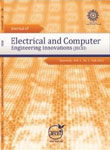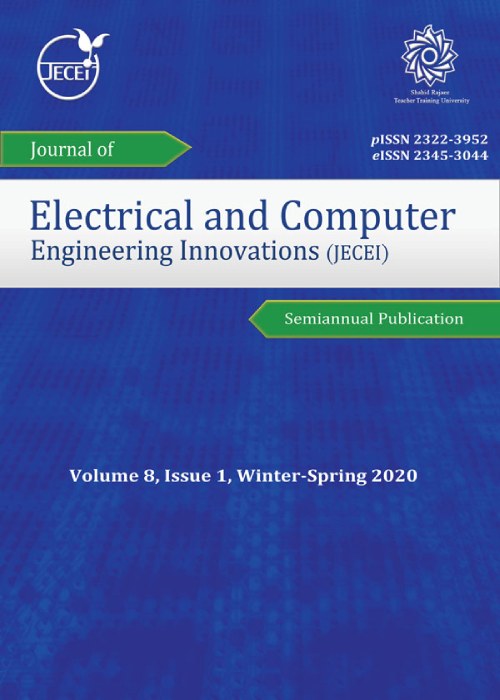فهرست مطالب

Journal of Electrical and Computer Engineering Innovations
Volume:1 Issue: 2, Summer - Autumn 2013
- تاریخ انتشار: 1392/08/14
- تعداد عناوین: 6
-
-
Pages 63-71Pulse-width modulated (PWM) adjustable frequency drives (AFDs) are extensively used in industries for control of induction motors. It has led to significant advantages in terms of the performance, size, and efficiency but the output voltage waveform no longer remains sinusoidal. Hence, overshoots, high rate of rise, harmonics and transients are observed in the voltage wave. They increase voltage and thermal stresses; resulting into accelerated insulation aging. This paper presents the application of fuzzy logic to life estimation of PWM driven induction motors. Insulation stress parameters are experimentally computed for wide range of switching frequency and used in fuzzy logic based life estimation algorithms. The results obtained with the fuzzy expert system show a performance approaching attainable for the life model based on the inverse power law.Keywords: Insulation aging, life model, peak voltage, thermal stress
-
Pages 73-81This paper presents a novel control method to improve the efficiency of low-voltage DC-DC converters at light loads. Pulse Width Modulation (PWM) converters have poor efficiencies at light loads, while pulse frequency modulation (PFM) control is more efficient for the same cases. Switching losses constitute a major portion of the total power loss at light loads. To decrease the switching losses and to increase efficiency, converters based on soft-switching are utilized. This paper presents the design of a soft-switching DC-DC buck converter in a 90-nm CMOS technology. Simulation results by HSPICE shows a 21 mV output ripple on a 0.5 V output voltage for an input voltage of 1.4 V. Finally, the efficiency of 95% at a load current of 50 mA having 74 mA of current ripple is achievable.Keywords: Synchronous buck converter, PFM control, Soft switch
-
Pages 83-88This paper presents a novel control approach used in shunt active power filter based on variable structure control combined with Random PWM technique (RVSC) that provides robust, fast, and more favorable performance for active power filter. This control strategy is compared with two other strategies to show the effectiveness of the introduced methods; pulse width modulated proportional-integral control (PIC), and Random Pulse Width Modulated proportional-integral control (RPIC). The simulation results with and without the shunt active power filter in the system are presented and analyzed. The simulation results show that the RVSC controller has a better performance than other control strategies, allowing compensation of reactive power, reducing high frequency harmonics thus overcoming the problem of electromagnetic interference (EMI), reducing dc current injection below the limit specified in IEEE-1547 standard, and also reducing the harmonic level below the limit specified in IEEE-519 standard.Keywords: Active power filter, Random PWM, Variable Structure Control, THD
-
Pages 89-97Recently, time reversal (TR) method, due to its high functionality in heterogeneous media has been widely employed in microwave imaging (MI) applications. One of the applications turning into a great interest is through-wall microwave imaging (TWMI). In this paper, TR method is applied to detect and localize a target obscured by a brick wall using a numerically generated data. Regarding this, it is shown that when the signals acquired by a set of receivers are time reversed and backpropagated to the target-embedded media, finding the optimum time frame which the constituted image represents a true location of the target becomes infeasible. Indeed, there are situations pertinent to the target distance ratio that the previously-used Maximum field method and Entropy-based methods may fail to select the optimum time frame. As a result, an improved method which is based on initial reflection from the target is proposed. According to different target locations described in this research, the results show this method prevails over the shortcomings of the former methods.Keywords: Finite, difference time, domain (FDTD), optimum focusing, target distance ratio, target initial reflection, through, wall microwave imaging, time reversal (TR)
-
Pages 99-105Sleep stages classification is one of the most important methods for diagnosis in psychiatry and neurology. In this paper, a combination of three kinds of classifiers are proposed which classify the EEG signal into five sleep stages including Awake, N-REM (non-rapid eye movement) stage 1, N-REM stage 2, N-REM stage 3 and 4 (also called Slow Wave Sleep), and REM. Twenty-five all night recordings from Physionet database are used in this study. EEG signals were decomposed into the frequency sub-bands using wavelet packet tree (WPT) and a set of statistical features was extracted from the sub-bands to represent the distribution of wavelet coefficients. Then, these statistical features are used as the input to three different classifiers: (1) Logistic Linear classifier, (2) Gaussian classifier and (3) Radial Basis Function classifier. As the results show, each classifier has its own characteristics. It detects particular stages with high accuracy but, on the other hand, it has not enough success to detect the others. To overcome this problem, we tried the majority vote combination method to combine the outputs of these base classifiers to have a rather good success in detecting all sleep stages. The highest classification accuracy is obtained for Slow Wave Sleep as 81.68% in addition to the lowest classification accuracy of 43.68% for N-REM stage 1. The overall accuracy is 70%.Keywords: sleep stages classification, EEG signals, wavelet packets, classifier combination, majority voting
-
Pages 107-114Continuous Stirred Tank Reactor (CSTR) has particular importance in chemical industry. CSTR has usually a nonlinear behavior which makes it difficult to control. The reactor has two parameters: the concentration and temperature of mixture both of which are uncertain. This case of CSTR has large disturbance in domain. In order for disturbance rejection, a controller has to be designed. In this paper, for modeling the CSTR system, first, the PI and PID controllers are designed by two methods, the automatic with Matlab Simulink and Ziegler-Nichols (Z-N) method. Then, reset control is replaced and tuned by their parameters. The main aim of this work is to compare the output responses (temperatures) of controllers with each other. In this work a reset controller is proposed for the thermal reactor model. Due to complexity of control of this plant, different design methods should be evaluated for disturbance rejection and input tracking. The results show that the reset controller is better than the PI controller in disturbance elimination. Finally, controller’s output response is investigated for improvement in disturbance rejection and change in the set-point.Keywords: Clegg Integrator, CSTR, PI+CI integrator


